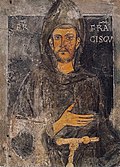
Giovanni di Pietro di Bernardone, known as Francis of Assisi, was an Italian mystic, poet and Catholic friar who founded the religious order of the Franciscans. He was inspired to lead a Christian life of poverty as a beggar and itinerant preacher. One of the most venerated figures in Christianity, Francis was canonized by Pope Gregory IX on 16 July 1228. He is commonly portrayed wearing a brown habit with a rope tied around his waist, featuring three knots that symbolize the three Franciscan vows of poverty, chastity, and obedience.
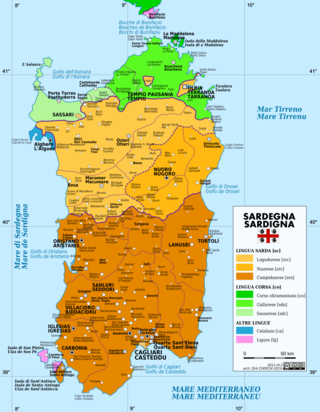
Logudorese Sardinian is one of the two written standards of the Sardinian language, which is often considered one of the most, if not the most conservative of all Romance languages. The orthography is based on the spoken dialects of central northern Sardinia, identified by certain attributes which are not found, or found to a lesser degree, among the Sardinian dialects centered on the other written form, Campidanese. Its ISO 639-3 code is src.

The Magnificat is a canticle, also known as the Song of Mary, the Canticle of Mary and, in the Byzantine tradition, the Ode of the Theotokos. It is traditionally incorporated into the liturgical services of the Catholic Church, the Eastern Orthodox Church, Lutheran Churches and the Anglican Communion. Its name comes from the incipit of the Latin version of the text.
A doxology is a short hymn of praises to God in various forms of Christian worship, often added to the end of canticles, psalms, and hymns. The tradition derives from a similar practice in the Jewish synagogue, where some version of the Kaddish serves to terminate each section of the service.

John Milford Rutter is an English composer, conductor, editor, arranger, and record producer, mainly of choral music.
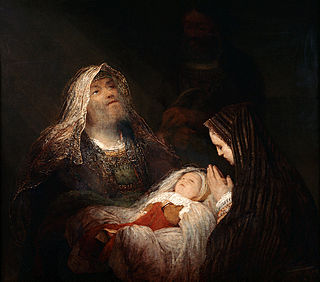
The Nunc dimittis, also known as the Song of Simeon or the Canticle of Simeon, is a canticle taken from the second chapter of the Gospel of Luke, verses 29 through 32. Its Latin name comes from its incipit, the opening words, of the Vulgate translation of the passage, meaning "Now you let depart". Since the 4th century it has been used in Christian services of evening worship such as Compline, Vespers, and Evensong.

The Benedictus, given in Gospel of Luke 1:68–79, is one of the three canticles in the first two chapters of this Gospel, the other two being the "Magnificat" and the "Nunc dimittis". The Benedictus was the song of thanksgiving uttered by Zechariah on the occasion of the circumcision of his son, John the Baptist.
Grayston "Bill" Ives is a British composer, singer and choral director.
"For the Beauty of the Earth" is a Christian hymn by Folliott S. Pierpoint (1835-1917).
Tarantino, spoken in the southeastern Italian region of Apulia, is a transitional language, most of whose speakers live in the Apulian city of Taranto. The dialect is also spoken by a few Italian immigrants in the United States, especially in California.

Thanksgiving after Communion is a spiritual practice among Christians who believe in the Real Presence of Jesus Christ in the Communion bread, maintaining themselves in prayer for some time to thank God and especially listening in their hearts for guidance from their Divine guest. This practice was and is highly recommended by saints, theologians, and Doctors of the Church.
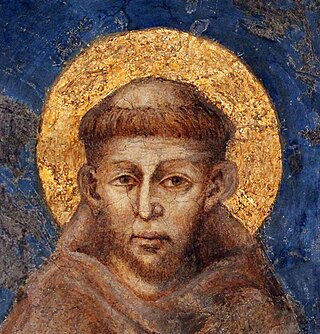
Le Laudi, Op. 25, is an oratorio by the Swiss composer Hermann Suter. The full title is Le Laudi di San Francesco d'Assisi . The text is Francis of Assisi's Canticle of the Sun in the original Italian. Suter scored the work for soloists, choir, children's choir, organ and large orchestra. It was premiered in 1924, with the composer conducting the Basler Gesangverein on the occasion of its centenary. The oratorio of around 70 minutes is one of Suter's most important works and has been championed by conductors such as Wilhelm Furtwängler, who conducted the first performance in Vienna in 1926 and further performances in Europe. Although now performed relatively rarely elsewhere, it has been presented regularly in Switzerland. It was also recorded in 1991 and 2007.

Marco Frisina is an Italian Roman Catholic priest and composer. He is director of the Pastoral Worship Center at the Vatican.
Laudato si' is the second encyclical of Pope Francis. The encyclical has the subtitle "on care for our common home". In it, the pope critiques consumerism and irresponsible development, laments environmental degradation and global warming, and calls all people of the world to take "swift and unified global action."

Helmut Alfons Schlegel is a German Franciscan Catholic priest, meditation instructor, author, librettist and songwriter. He is known for writing new spiritual songs, set to music by various composers.
Laudato si' is medieval Central Italian for 'Praise be to you'.
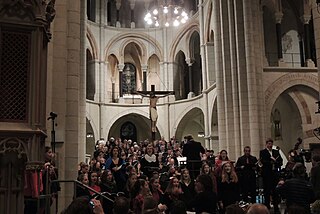
Laudato si' is an oratorio composed in 2016 by Peter Reulein on a libretto by Helmut Schlegel. Subtitled Ein franziskanisches Magnificat, it includes the full Latin text of the Magnificat, expanded by writings of Clare of Assisi, Francis of Assisi and Pope Francis. The composer set it for five soloists, children's choir, Choralschola, mixed choir, symphony orchestra and organ. It was published in 2016 by the Dehm Verlag, and was premiered on 6 November 2016 at the Limburg Cathedral, conducted by the composer.
The Daily Office is a term used primarily by members of the Episcopal Church. In Anglican churches, the traditional canonical hours of daily services include Morning Prayer and Evening Prayer, usually following the Book of Common Prayer. As in other Christian traditions, either clergy or laity can lead the daily office. Most Anglican clergy are required to pray Morning and Evening Prayer daily.
Laudate Deum is an apostolic exhortation by Pope Francis, published on October 4, 2023. It was released on the 2023 Feast of St Francis Assisi as a follow-up to his 2015 encyclical Laudato si'. The text is about 8,000 words divided into 73 paragraphs.

![Reproduction of the Codice 338, f.f. 33r - 34r, sec. XIII - Biblioteca del Sacro Convento [it] Cantico delle Creature.djvu](http://upload.wikimedia.org/wikipedia/commons/thumb/3/30/Cantico_delle_Creature.djvu/page1-220px-Cantico_delle_Creature.djvu.jpg)











